

IKEA SWOT Analysis
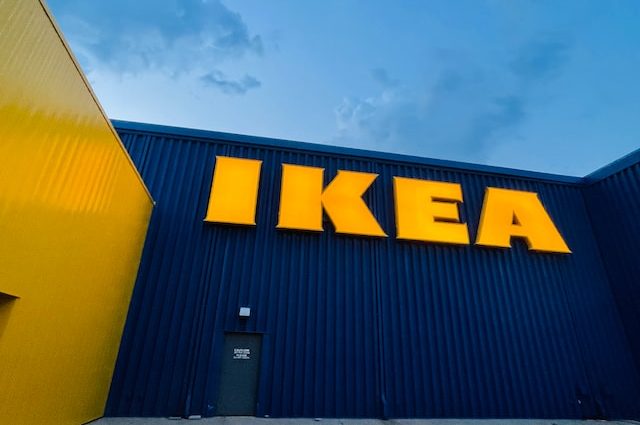
Before we dive deep into the SWOT analysis, let’s get the business overview of IKEA. IKEA is a multinational company specializing in designing, manufacturing, and selling ready-to-assemble furniture, kitchen appliances, and home accessories. Founded in 1943 by Ingvar Kamprad in Älmhult, Sweden, IKEA has become one of the world’s largest and most successful furniture retailers.
Business Model: IKEA’s business model is centered around providing affordable, functional, and stylish home furnishings to customers across the globe. The company achieves this through its unique combination of low-cost production, efficient supply chain management, and a self-service, warehouse-style shopping experience.
- Low-cost production: IKEA designs its products to be simple and easy to manufacture, which helps to reduce production costs. The company often uses flat packaging, which minimizes shipping and storage costs, and allows customers to assemble the products.
- Efficient supply chain management: IKEA maintains close relationships with its suppliers and works to optimize its supply chain, minimizing costs and ensuring timely delivery of products. This efficiency allows the company to maintain its competitive pricing.
- Self-service concept: IKEA stores are designed to facilitate a self-service shopping experience, with customers navigating through showrooms, picking up products from warehouse-like areas, and assembling the products at home. This approach reduces staffing costs and encourages customer involvement and satisfaction.
Product Range: IKEA offers a wide range of products, including furniture, storage solutions, lighting, textiles, kitchen appliances, and decorative items. The company’s products are designed to cater to a diverse range of customers, with various styles, materials, and price points available.
Global Presence: Since its inception, IKEA has expanded its operations to over 50 countries, operating more than 400 stores worldwide. In addition to its brick-and-mortar locations, IKEA also uses an e-commerce platform, allowing customers to purchase products online and deliver them directly to their homes.
Sustainability and Social Responsibility: IKEA is committed to sustainability and minimizing its impact on the environment. The company invests in renewable energy, focuses on using sustainable materials in its products, and aims to become a circular business by 2030. Additionally, IKEA is involved in various social initiatives and partnerships, such as working with UNICEF and Save the Children to improve the lives of needy children.
In summary, IKEA is a global leader in the home furnishings industry, known for its affordable, functional, and stylish products. The company’s unique business model, wide product range, global presence, and commitment to sustainability and social responsibility have contributed to its success and growth.
IKEA’s total retail sales for FY22 reached EUR 44.6 billion (EUR 41.9 billion in FY21). This includes sales of IKEA products, food, and services to customers.
Here is the SWOT analysis for IKEA
A SWOT analysis is a strategic planning tool used to evaluate the Strengths, Weaknesses, Opportunities, and Threats of a business, project, or individual. It involves identifying the internal and external factors that can affect a venture’s success or failure and analyzing them to develop a strategic plan. In this article, we do a SWOT Analysis of IKEA.
SWOT Analysis: Meaning, Importance, and Examples
- Economies of scale : As one of the largest furniture retailers globally, IKEA benefits from economies of scale, which allow the company to achieve cost advantages in production, procurement, and logistics. This enables IKEA to offer competitive pricing to its customers.
- Strong brand identity : IKEA has cultivated a unique and consistent brand identity. Its minimalistic Scandinavian design, affordable prices, and innovative furniture and home goods approach have made it a household name worldwide.
- Wide product range : IKEA offers a comprehensive range of products, catering to various customer segments, tastes, and budgets. This extensive product offering helps IKEA appeal to a broad audience and meet the diverse needs of its customers.
- Efficient supply chain : IKEA’s efficient supply chain management and close relationships with suppliers enable the company to streamline its operations, reduce costs, and maintain product availability, further enhancing its competitiveness in the market.
- Innovative store layout and customer experience : IKEA’s distinctive store layout, which combines showrooms and warehouse-style shopping, creates a unique and engaging customer experience. This self-service approach encourages customers to explore and interact with products, increasing the likelihood of sales.
- Global presence : With over 400 stores across more than 50 countries, IKEA has established a solid global footprint. This international presence enables the company to cater to local tastes and preferences while benefiting from global brand recognition.
- Commitment to sustainability : IKEA’s focus on sustainability and environmental responsibility has resonated with customers and helped to differentiate the brand from its competitors. The company’s initiatives, such as using sustainable materials and investing in renewable energy, contribute to a positive brand image.
- Digital transformation and e-commerce : IKEA has embraced digital transformation, investing in its online presence and e-commerce platform to cater to consumers’ changing shopping habits. This has allowed the company to expand its reach and maintain its relevance in the age of online shopping.
- Complex assembly process : Although IKEA’s flat-pack, ready-to-assemble products help reduce shipping and storage costs, some customers find the assembly process challenging or time-consuming. This could deter potential customers or lead to dissatisfaction among those who struggle with assembly.
- Perceived product quality : Due to its focus on affordability, some customers may perceive IKEA products as being lower quality than more expensive alternatives. This perception could limit IKEA’s appeal to customers seeking higher-end or longer-lasting furniture.
- Limited customization : IKEA’s standardized designs and production methods can restrict the level of customization available to customers. This might make it difficult for the company to cater to individual tastes and preferences, especially compared to smaller, bespoke furniture manufacturers.
- Dependency on large store formats : IKEA’s traditional reliance on large, out-of-town store locations can lead to higher operational costs and may not be as convenient for customers who prefer shopping in urban centers or online.
- Environmental impact : Despite its commitment to sustainability, IKEA’s business model is not without its environmental impact. The company’s reliance on wood and other raw materials and the transportation of goods can contribute to resource depletion and carbon emissions.
- Cultural adaptation challenges : As IKEA expands into new markets, it may face difficulties adapting its product offerings and store layouts to cater to the local culture, preferences, and regulations. This could affect IKEA’s ability to establish a strong presence in certain regions.
- Market saturation and competition : In some mature markets, IKEA faces increased competition from traditional furniture retailers and e-commerce platforms. This market saturation can lead to slower growth and increased pressure to differentiate its product offerings and customer experience.
- Supply chain disruptions : IKEA’s vast and complex global supply chain can be susceptible to disruptions, such as natural disasters, political instability, or global pandemics. These disruptions can impact product availability, increase costs, and negatively affect the company’s reputation.

Opportunities
- Expansion into emerging markets : IKEA can target untapped markets, particularly in Asia, Africa, and South America, to increase its global presence and tap into the growing demand for affordable and stylish home furnishings.
- Enhancing online presence and e-commerce : By investing in its e-commerce platform and digital marketing efforts, IKEA can cater to the increasing number of customers who prefer shopping online. This will help IKEA broaden its customer base and remain relevant in the digital age.
- Customization and personalization : Offering customers more options to customize and personalize their furniture can help IKEA differentiate itself from competitors and cater to the increasing demand for personalized products.
- Smaller and urban store formats : Opening smaller, urban store formats can help IKEA reach customers in densely populated cities where large store formats are not feasible. These smaller stores can offer a curated selection of products tailored to the needs of urban dwellers.
- Sustainability and circular economy : IKEA can further strengthen its commitment to sustainability by focusing on circular economy initiatives, such as promoting product reuse, repair, and recycling. This can improve IKEA’s brand image and appeal to environmentally-conscious consumers.
- Smart home technology integration : Integrating smart home technology into IKEA’s product offerings can help the company stay ahead of market trends and cater to the growing demand for connected, intelligent home solutions.
- Collaboration with designers and artists : By collaborating with renowned designers and artists, IKEA can introduce exclusive, limited-edition collections that can help differentiate its product offerings, create buzz, and attract new customers.
- Strengthening the supply chain : Investing in supply chain innovations, such as automation and artificial intelligence, can help IKEA further optimize its supply chain, reduce costs, and mitigate risks associated with disruptions.
- Intense competition : IKEA faces strong competition from both traditional brick-and-mortar furniture retailers and e-commerce platforms. Competitors may offer similar products at competitive prices, alternative designs, or superior customer experiences, putting pressure on IKEA to continually innovate and differentiate itself.
- Economic downturns : Economic recessions or downturns can lead to reduced consumer spending on discretionary items like furniture and home accessories. This can result in decreased sales and lower profits for IKEA.
- Fluctuations in raw material prices : IKEA relies heavily on raw materials, such as wood, textiles, and metals, to manufacture its products. Fluctuations in the prices of these materials can lead to increased production costs and potentially affect IKEA’s profitability and competitive pricing.
- Regulatory and political risks : As a global company, IKEA is exposed to various regulatory and political risks in its operating countries. Regulation changes, political instability, or trade restrictions can impact IKEA’s supply chain, operations, or market access, leading to increased costs or reduced sales.
- Changing consumer preferences : Consumer tastes, furniture, and home goods preferences can change rapidly. Failure to adapt to these changes and offer products that resonate with customers can decrease sales and market share.
- Environmental concerns : Growing concerns about the environmental impact of businesses, including resource depletion, carbon emissions, and waste generation, can affect IKEA’s reputation and demand for its products. Failing to address these concerns or meet evolving sustainability standards could harm IKEA’s brand image and customer loyalty.
- Technological disruptions : Rapid technological advancements, particularly in e-commerce, logistics, and manufacturing, can disrupt IKEA’s traditional business model. Failure to adapt and embrace new technologies can hinder IKEA’s competitiveness and market position.
- Supply chain disruptions : IKEA’s complex global supply chain is vulnerable to disruptions from natural disasters, political instability, labor strikes, or global health crises. These disruptions can lead to increased costs, delays, and damage to IKEA’s reputation for product availability.
Check out the SWOT Analysis of Global Businesses
Related posts.

T Mobile SWOT Analysis
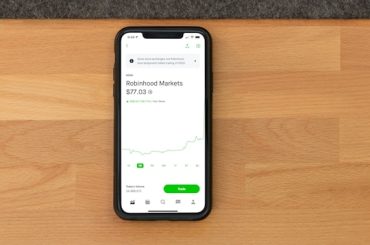
Robinhood SWOT Analysis

Revlon SWOT Analysis

Rebisco SWOT Analysis

Razer SWOT Analysis
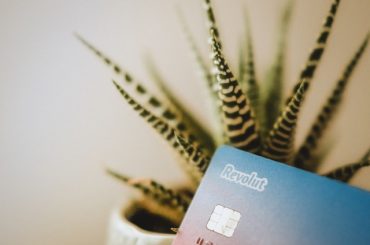
Revolut SWOT Analysis
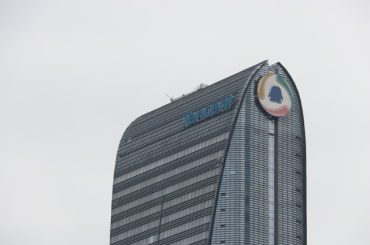
Tencent SWOT Analysis

Telus SWOT Analysis
Type above and press Enter to search. Press Esc to cancel.
- In-Depth SWOT Analysis of IKEA
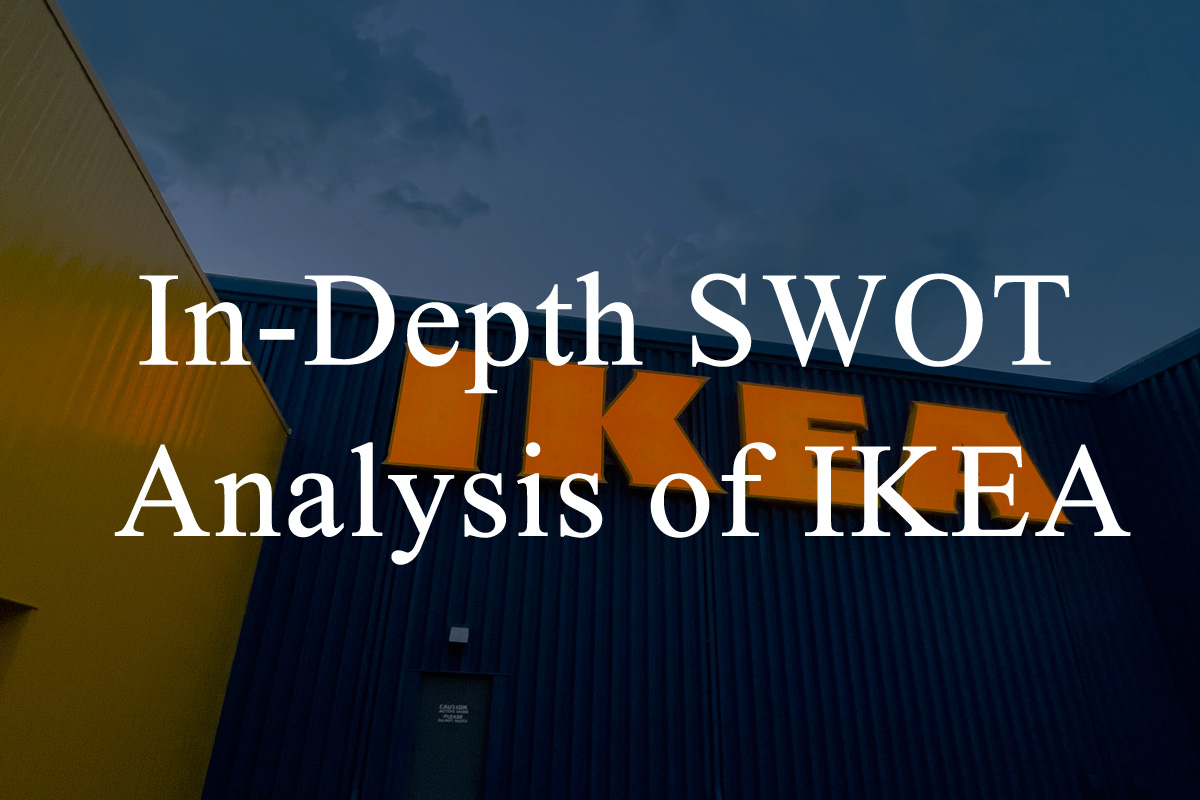
Introduction
IKEA has grown from humble beginnings to become the world's largest home furnishings retailer, with over 300 locations in a variety of nations. IKEA capitalizes on its strengths and mitigates certain shortcomings thanks to strong resource planning and allocation. The purpose of this IKEA SWOT analysis is to show the strengths, opportunities, and threats that exist in the home furnishing business, as well as how IKEA has succeeded to rise through the ranks. With its first store opening in Norway in 1963, the company entered the flat-pack furniture business. Following that, the business has been able to attract millions of new clients each year.
Indeed, IKEA has made great success over the world. In this IKEA SWOT analysis, we'll take a closer look at a variety of elements that have influenced the company's decision-making throughout the years. A significant emphasis is placed on the company's strengths as well as the numerous prospects. Meanwhile, some vulnerabilities and risks need to be addressed in the future.
2. IKEA's Strengths
IKEA's greatest strength is its clear vision, which is to provide value to its consumers regardless of market situations. This has resulted in a clear and well-defined company strategy and retailing method that is innovative in its simplicity, lethal in its competition targeting, and successful in its positioning.
Another significant asset of the firm is its straightforward idea, which converts into a variety of items that consumers can build themselves, resulting in massive cost savings that are then carried on to the consumers. IKEA has risen to become the world's biggest furniture retailer because of its single-minded concentration on cost leadership.
Increased use of recycled resources, wiser use of raw resources, creating and sustaining long-term partnerships with suppliers, and exploiting the efficiencies and synergies from economies of scale are some of the criteria used by IKEA to assess its strengths.
Moreover, this large selection of designs is reasonable for the typical person, and after acquiring the furniture, it assists in the delivery of your items to your house, thereby lowering consumer expenses.
3. IKEA's Weaknesses
Given that IKEA operates in several nations throughout the world, it is a large-scale and large-scale business, making it challenging to maintain consistent standards across sites. Though the organization makes every effort to ensure consistent quality across its product line and its locations, quality assurance that is reproducible and scalable is a major flaw.
Quality occasionally suffers as a result of the company's obsessive focus on cost leadership, especially in the current environment, when the costs of numerous inputs and raw materials have risen, affecting the company's financial performance. It's worth noting that maintaining quality in the face of rising expenses might be challenging at times.
The poor quality of their items has been the main source of worry. Many consumers have complained about their furniture falling within a few days after it was set up. When it comes to necessities in people's everyday lives, quality appears to be significantly more crucial when making purchasing selections.
IKEA's operations raise environmental issues, and the firm has difficulty explaining and expressing its environmental policy to consumers, shareholders, and other stakeholders.
4. IKEA's Opportunities
With its "green" marketing strategy, the business has a big possibility to attract clients who are interested in purchasing such items. The emergence of the ethical consumer, or the "Ethical Chic" purchase process, which indicates that buyers would want to buy ecologically aware items, is an opportunity waiting to be unleashed for the organization.
The company's cost leadership, which entails a single-minded concentration on cost at the detriment of all else, is maybe its largest opportunity. While this has generated quality issues, customers do not appear to mind because they are receiving their money's worth, and adding value to customers is another important possibility.
IKEA benefits from being a well-established market player, despite the severe rivalry in the furniture business. As a result, the corporation will have a better understanding of how to operate the business. As a result, expanding into additional nations may result in more new clients, resulting in more revenue. With the growth of the internet, more businesses are relocating their operations online.
The company's development into emerging countries and the developing globe, where it has an untapped client base that can be used for effective profitability, is the second potential. IKEA is already planning to enter areas such as China and India with a defined cost leadership strategy, which it expects would benefit the firm.
5. IKEA's Threats
IKEA's low-cost business strategy has been copied and duplicated by competitors, implying that the corporation must continually innovate to stay ahead of the pack. For example, some regional and local businesses have jumped on the DIY bandwagon and are concentrating on cost-cutting, forcing IKEA to develop new methods to remain flexible and adaptable.
DIY as a primary driver of strategic success is no longer the sole Unique Selling Proposition of IKEA, and the growth of online merchants that can provide even lower costs since they do not have a real presence means that they are closing in on IKEA.
Another issue is employee unhappiness, which has led to litigation and may cost the corporation millions in settlements and legal bills due to claims of maltreatment and unpaid overtime.
IKEA is also seeing a decrease in the number of new customers. Given the risks facing IKEA, it would be disastrous for the company's future if it did not come up with specific remedies to retain its market dominance.
6. Mind Map
The SWOT Analysis is used to examine the strategy of IKEA, the world's largest furniture store. The Do It Yourself (DIY) concept ensures that the company keeps costs low and passes on the value to customers. The company was founded in 1943 and is known for its simple yet effective approach to retailing with the DIY or Do It Yourself concept, which ensures that the company keeps costs low and passes on the value to customers. IKEA's items are typically ready to use and flat packaged, which means that buyers may put them together themselves. The corporation is also active in the internet realm, with annual revenues of more than a billion dollars from both online and offline operations.

7. Key Takeaways
A corporation may use a SWOT Analysis to get a thorough look at the aspects to consider while making decisions. As new possibilities arise, a corporation can learn how to take advantage of them. IKEA might also concentrate on potential risks and challenges to their business. IKEA can make their products models more adaptable and responsive to changing market conditions by making full use of the possibilities that occur. IKEA is a well-known worldwide trend, and it has managed to stay ahead of the competition in the furniture retailing market because of its creative business strategy and concentration on goods, processes, and systems.
The company may diversify into other items and product lines since its business model can be replicated in other areas. To do so, it would take new thinking and a new approach to its strategy, combining low-cost leadership with other success factors such as scalability and quality emphasis. Finally, the corporation may expand into new areas, where its products and business strategy are more likely to succeed, and an untapped client base can be exploited. It can all be summarized in a mind map diagram, just like below. You can make one or edit any template available in EdrawMind, and not only that, but you can also make the mind map diagram from scratch.
8. References
- SWOT Analysis of IKEA 2021: Strengths & Weaknesses

In-Depth SWOT Analysis of Tesla
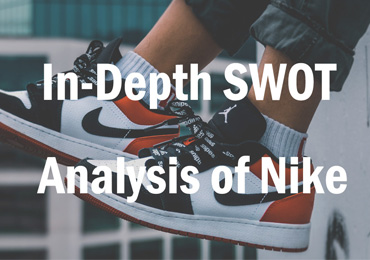
In-Depth SWOT Analysis of Nike

McDonald's SWOT Analysis 2023

SWOT Analysis of Gucci

In-Depth SWOT Analysis of Netflix

Zara Segmentation, Targeting, and Positioning
Academia.edu no longer supports Internet Explorer.
To browse Academia.edu and the wider internet faster and more securely, please take a few seconds to upgrade your browser .
Enter the email address you signed up with and we'll email you a reset link.
- We're Hiring!
- Help Center
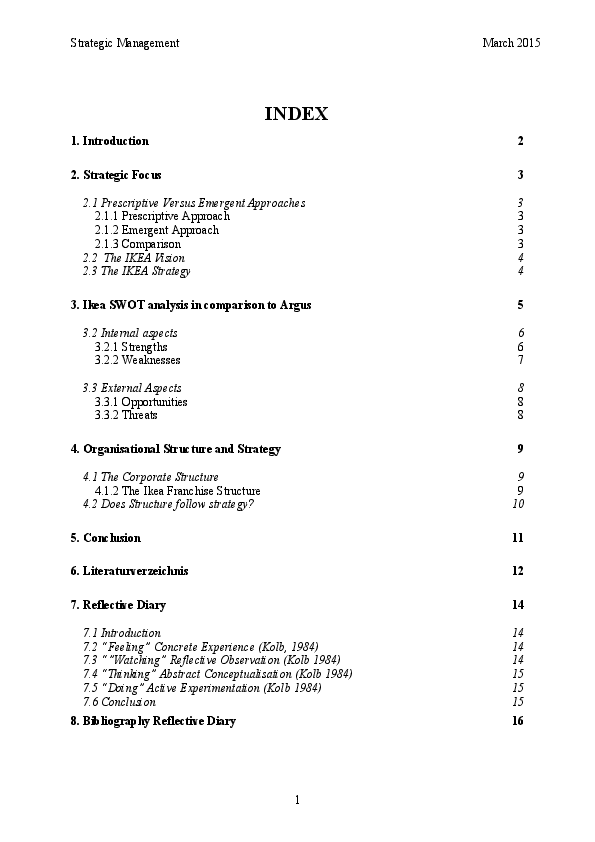
IKEA SWOT analysis, strategy and structure
Related Papers
Kevin Zentner , Rachel Killoh , Zhen Sun
Ikea is a worldwide success story; their stores were visited 915 million times and their website was accessed over 2 billion times in 2016 (Highlights, 2016). As the world’s largest furniture retailer, Ikea services a number of market segments. With significant volume discounts and a vertically integrated supply chain, the production of low-cost goods target young families and low income segments. Conversely, the flagship Stockholm line of furniture entices sophisticated consumers towards mid-priced, superior value products with quality materials such as walnut, bone china, and rustic grain leather.
Anthony Olabode Ayodele (Bode Ayodele)
kelvin mulenga
This Briefing Paper has been designed to critically evaluate the application of Total Quality Management (TQM) in the world’s leading furniture company, IKEA. The paper will further critique and outline how IKEA holistically approaches the concept of TQM, applying it numerous principles across the various aspects of the business, and in general as a whole. A 10 minute accompanying video linked via a picture at the end of the report is also included.
Shivang Soni
Case Reports
Canadian Medical Association Journal
David Wetter
Michel OKIEMY
En depit d’enormes potentialites de productions vegetales, animales, halieutiques et forestieres dont dispose le pays, la part du secteur agricole dans la formation de la richesse nationale ne cesse de regresser. but de ce papier est d’analyser la contribution de la croissance de l’agriculture dans la reduction de la pauvrete au Congo. Pour ce faire, nous nous sommes appuyes sur la revue theorique et empirique. Apres analyse des resultats issue du Modele a Correction d’Erreur, il ressort que la part de l’agriculture au PIB est relativement faible, et par consequent, la croissance de l’agriculture contribue faiblement a la reduction de la pauvrete au Congo. En effet, si la productivite agricole augmente de 1%, la consommation finale des menages par habitant va baisser de 2,52182%, toute chose egale par ailleurs. Ces resultats contrastent avec l’hypothese selon laquelle, la croissance de l’agriculture contribue a la reduction de la pauvrete .
Analytical Letters
Anthony Turner
Revista En-contexto
Eneida Avila
La calidad se ha aplicado desde tiempos remotos; sin embargo, la situación actual de las organizaciones ha hecho que las empresas implementen Sistemas de Gestión de Calidad (SGC) para incrementar la satisfacción del cliente y adquirir ventaja. El presente trabajo presenta una reflexión respecto a las ventajas y desventajas de los SGC, con el fin de ampliar la perspectiva del lector. Siguiendo la metodología de revisión de literaturas, se obtuvo que entre las ventajas se encuentran la profundización y mejora de procesos, la inclusión de aspectos ambientales y sociales, el refuerzo de la estructura organizacional y la confianza percibida por el cliente al adquirir productos de calidad; mientras que en las desventajas se detectan los altos costos, incremento en el número de empresas certificadas, mala toma de decisiones por certificarse rápidamente, el impedimento en la innovación y el desarrollo de nuevos productos, entre otras que se describen en el desarrollo del presente artículo.
RELATED PAPERS
Fany Galender
Caderno CRH
Maria Estima Ribeiro
Edwin Quiros
Ricardo David Andrade Pizarro
Frontiers in Psychology
Sarwar Kabir
Marina Fleury
Leila Giovana Izidoro
Annals of Surgical Oncology
Ambreen Moatasim
Actes de la conférence RFIA 2012
Antony Coustou
Inorganic Chemistry
The Education and science journal
Fayruza Ismagilova
International Transactions in Operational Research
Celso Cavellucci
Kluwer Academic Publishers eBooks
Martin Malawer
Proceedings of the Institution of Mechanical Engineers, Part C: Journal of Mechanical Engineering Science
Zineb Achegaf
Revista Mexicana de Ciencias Agrícolas
jose cruz carrillo rodriguez
Journal of emerging technologies and innovative research
SAMBIT MAITI
Journal of North Khorasan University of Medical Sciences
Ahmad modaber RAHIMI
Quarterly Journal of Experimental Psychology
James R . Schmidt
Heru Cahyono
RELATED TOPICS
- We're Hiring!
- Help Center
- Find new research papers in:
- Health Sciences
- Earth Sciences
- Cognitive Science
- Mathematics
- Computer Science
- Academia ©2024
The SWOT Analysis of IKEA
Ever since its inception, IKEA has risen to be the world’s largest home furniture retailer with over 300 stores in numerous countries around the globe. Due to the excellent resource planning and allocation, IKEA capitalizes on its strengths and counter specific weaknesses. Here IKEA SWOT analysis is given to illustrate the strengths, opportunities, and threats in the home furnishing industry and how IKEA has managed to emerge on top.

1. The Development of IKEA
Ever since founded in 1943 in Sweden, IKEA has developed and innovated the home furnishing sector. Established by Ingvar Kamprad at the tender age of 17, this young entrepreneur was destined to change the world. He drew the inspiration of the company’s name from the initials of his name and the initials from his family’s farm, Elmtaryd, and his home village, Agunnaryd.
At the very beginning, IKEA engaged in selling small items such as pens and lighters, from where it grew into the industry giant today. The company got into flat-packing of furniture with its first store that opened in Norway in 1963. Afterward, the company has managed to attract millions of new customers every year. Indeed, the fact that IKEA has made significant progress worldwide.
In this IKEA SWOT analysis , an in-depth look that focuses on numerous factors that have shaped the company’s decision making over the years. Here, a special focus is on the strengths of the company and the various opportunities. Meanwhile, weaknesses and threats are mentioned that should be settled in the future.
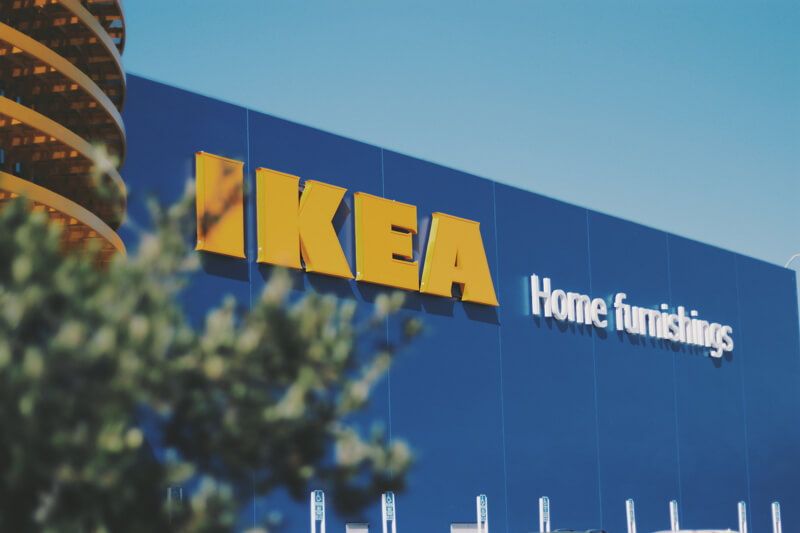
2. The SWOT Analysis of IKEA
A SWOT analysis is an efficient method to analyze the components that help a business thrive or contribute to its development. SWOT stands for strengths, weaknesses, opportunities, and threats. Strengths and weaknesses are internal factors, where as opportunities’ and threats are external factors.
- Strengths: these are the advantages that are better then competitors in the market;
- Weaknesses: the weak part when compared with others and may demage the brand;
- Opportunities: the chances that company should grasp in the recent time;
- Threats: the potential threat that should avoid in the future.
This section focuses on the strengths that have enabled IKEA to become the largest home furnishing retailer of the 21st century. Accordingly, there are both internal and external strengths to ensure its position in the market. The most outstanding strengths of IKEA are:
- Design and Creation
- Affordability
- Brand Recognition
- Market Research
As we all know, IKEA is famous for its design and creation over the world. When people wanted to buy furniture, the first choice came into their mind is IKEA, since it offers most fashionable and exquisite design. Furthermore, this wide range of designs is also affordable for the average of people, and after purchasing the furniture, it supports to transport your goods to you home which can effectively reduce customers' costs.
IKEA has been in the market since 1914, thus it is the reason why IKEA enjoys good reputation. Besides, IKEA also has a very vibrant marketing team that has enhanced its market research and thus enabled them to venture into new markets. From this IKEA SWOT analysis , it shows how the company has managed to remain a pacesetter.
As for this section, it mainly illustrates the weaknesses or shortcomings of IKEA. Weaknesses are inadequacies that result from both internal and external factors and if not properly handled can result in huge financial losses. The main weaknesses listed as below:
- Poor Product Quality
- Difficulty for Assembling
- Shipping Problem
- Negative Press
IKEA remains several weakness that may damage its market share and brand image in some degree. The primary concern has been the poor quality of their products. Many people have reported their furniture breaking down just a few days after setting up. As for the necessity in people’s daily life, the quality seems far more important when making buying decisions.
What’s more, consumers being unable to assemble their furniture, which could result in the missing pieces such as screws and nuts. Since IKEA opened in numerous countries, it could bring logistics difficulties in shipping and delivery. Plus, another weakness for IKEA is the sustainable issues, for instance, the bad press about complaints from the staff due to long working hours. According to its weaknesses, it is better to avoid the negative effects.

This section focuses on the opportunities available for the company to grow even further. An opportunity is a chance to capitalize on market conditions in a bid to get the utmost benefit from this. These are the external factors that IKEA can capitalize on:
- Online Shopping
- More Storefronts
Through the fierce competition in furniture market, IKEA has the benefits of being an established market player. This thus allows the company to have proper knowledge on how to run the company better. As a result, reaching to more countries could increase more new customers so as to increase revenue. With the advancement in the internet, more companies are moving online. IKEA can capitalize on this platform and therefore enables a wider customer reach.
To maintain all the new consumers and create a good user experience, the company should set up more storefronts all over the country to ensure everyone has access to this brand. Except the furniture section, it is suggestible for IKEA to enter into more new markets, such as food industry, fashion industry and so on. These aspects of the IKEA SWOT analysis will enable the company to see more of its arising opportunities and how to capitalize on them better.
Threats could damage the brand in some aspects, so firstly figure out the threats then keeping changing and optimizing in the future. Some of the weaknesses also double up as threats. In this section, it mainly concludes the threats that IKEA could face up in the market:
- Strong Competition
- Disgruntled Employees
- Sustainability Problem
- Lower Market Penetration
With more and more companies coming into the home furnishing industry, the increased competition among them could hurt the position of IKEA. Global brands such as Walmart are on the verge of claiming consumers from IKEA. Another threat is dissatisfaction from employees who have often claimed mistreatment and unpaid overtime, which thus resulted in lawsuits and may cause the company millions in settlements and legal fees.
Nowadays, the sustainability is highly mentioned by consumers who advocate green purchasing. At this time, the waste of raw material and massive productions could hurt environment. Furthermore, IKEA is also recording reduced numbers of new consumers. Considering the threats for IKEA, it is catastrophic for company’s development that IKEA should come up with certain solutions to maintain its market share.
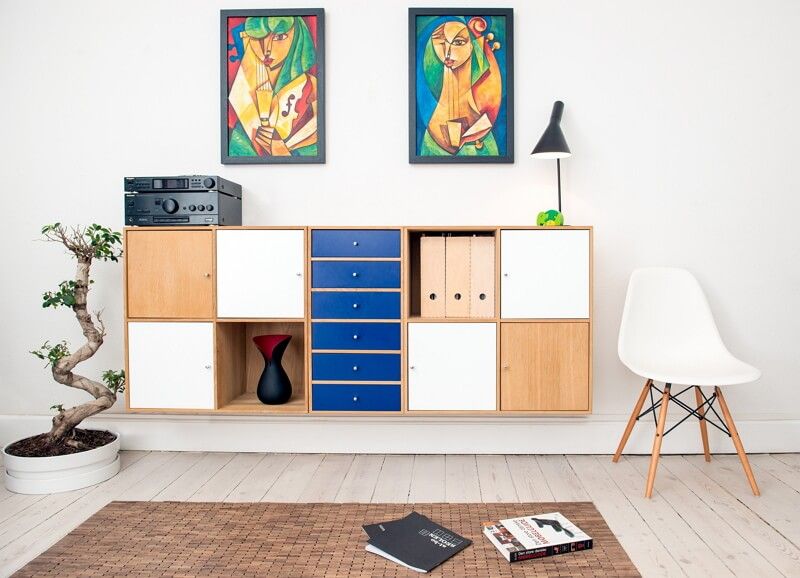
3. Wrapping Up
From a SWOT Analysis, a company can have a detailed look at the factors to consider in decision making. A company can learn how to make use of the various opportunities as they turn up. Here, IKEA can also focus on the threats and challenges to their business that may arise. By taking proper advantage of the opportunities that arise, IKEA can make their business models more flexible and adaptable to the changing market circumstances.
Related Articles

IKEA: SWOT, McKinsey 7S, Porter’s Diamond Analyses
Swot analysis.
Ikea is a business leader in terms of sales of products and services within the UK market and across Europe, which translates into a strong and stable market presence for its furniture and home appliances. Ikea offers very attractive customer care, discounts, and price-friendly products and services as part of the competitive advantage strategy. The company has multiple products and services as part of portfolio balance to minimise the effects of market swings in one sector of business. Ikea has been in operations for more than five decades, from the year 1943 (Ikea 2016). Thus, strong brand image and knowledge of the market is a plus for its business activities as illustrated in appendix 1.
Due to the existence of several alternatives existing in the market, Ikea has become a victim of high brand bargaining power since product switching is very easy, especially for the ready-to-assemble-furniture brand. Besides, the company is not effectively rolling out its franchise and vertical integration strategies (Ikea 2016).
Opportunities
The company’s strong brand image can be used to roll out new products in the UK market and beyond. The company might also diversify the current products to appeal to more customer segments through simple adjustments on design and functionality. The company also has the opportunity to improve on its current marketing strategies since it generates a lot of revenues (Ikea 2016).
Stiff competition from companies such as Argos is threatening the current gains the company has made in the market as indicated in appendix 2.
7S by McKinsey
The main elements of 7S as proposed by McKinsey are strategy, structure, systems, shared values, skills, style, and staff as summarised in Appendix 3. Ikea has balanced these aspects and they are currently positively skewed towards the growth strategies in product development within the UK market.
Value Chain
Ikea is strategic and responsive to the needs of its customers through product distribution, along with the customer centricity business model. For instance, the current model for managing the supply chain at Ikea assumes the linear strategy where different products are distributed based on need and targeted market. The current supply chain is also dynamic to changes in the market through the integration of different distributors and agents across the UK and Europe markets, as part of the business functionality (Dagnino & Rocco 2009).
Balanced Score Card
Since Ikea operate within a competitive market in the UK and other parts of the globe, the company has series of success factors such as innovation, financial standing, effective customer management, and efficient internal business process (Cheverton 2011). Specifically, Ikea’s retail business model has been effective in aligning its business objectives with the underlying factors that influence business sustainability as summarized in appendices 4, 5, 6, and 7.
Porter’s Diamond Analysis
Factor conditions.
Ikea has a very strong financial arm that has guaranteed sustainable investment in product differentiation (Cone 2011). The company also has a diverse portfolio in the form of home appliances, accessories, and furniture besides the highly skilled labour force.
Demand Conditions
The company’s products are used daily by clients, especially home accessories and appliances. This makes the demand for Ikea products high within the global markets, especially within the company’s furniture brand (Cone 2011).
Related Industries
Ikea has formulated a series of business partnerships with other firms such as the Simsbury, TML, and DHL as a strategy for sustaining its foreign markets. Also, the company has franchised some of the appliances brands as an expansion strategy to gain competitive advantage (Kluger 2011).
Strategy, Structure, and Rivalry
Ikea’s brands such as flat-pack houses, CIGS solar panels, Medium-Density Fibreboard technology in furniture, and DUKTIG toy line are very innovative. These brands have created a sustainable and proactive business environment for the company in the UK and across the globe (Ikea 2016).
Ikea’s financial standing has been stable for the last decade. The total sale for the 2015 financial year was recorded at $35.7 billion, which is 11.2% higher than the previous year. The total assets also grew from $340 billion in the year 2009 to $423 billion by the end of the 2015 financial year. The liabilities of Ikea rose from $961.82 million in 2013 to $1,242.50 million by the end of the 2015 financial year. Considering the positive performance, Ikea is in a position to sustain growth and business in the foreseeable future.
Resource Audit
Ikea has strategies and channels in place to guarantee optimal resource utilization for maximum productivity. The current production culture embodies efficiency through value maintenance, soft skills, and proper balance between the long-term and short-term resource utilization.
Cultural Paradigm
The physical work environment at Ikea encourages effectiveness in employee performance since there are a series of structured congenial and motivational attributes. These structures promote comfort, convenience, job security, and career growth. At present, Ikea is among the top ten global brands with the happiest workforce. The company has systems to guarantee stable work conditions, welfare support, and teamwork.
Recommendations
Based on the challenge competition and high brand bargaining power as identified in the above analysis, Ikea should consider the introduction of competitive pricing, multiple product development, and unique market targeting to increase its competitive advantage currently enjoyed by Ikea, especially in the furniture brand (Kotler & Keller 2012). This is in line with the cognitive strategy proposed by Mintzberg, which proposes that marketers should embrace an exceedingly organized and expansive separation system in planning market division approaches (Witcher & Chau 2010).
This approach is instrumental in setting up the broadest conceivable instrument for product positioning to improve profits for particular elements, which make the item exceptional and engaging target customers (Robbins, Millicent, & Jones 2010). Besides, Ikea should reduce the effects of high brand bargaining power through the creation of multiple products from a single product to an environment of self-competition, especially in the home appliances and accessories brand (Eugene & Michael 2009; Robbins, Millicent, & Jones 2010). This strategy will create an environment of own competition besides increasing benefits from economies of scale.
Reference List
Cheverton, P 2011, Key marketing skills: strategies, tools, and techniques for marketing success , Kogan Page, London.
Cone, S 2011, Steal these ideas: Marketing secrets that will make you a star , John Wiley & Sons, New York.
Dagnino, G & Rocco, E 2009, Competition strategy: theory, experiments, and cases , Rutledge, New York.
Eugene, F & Michael, C 2009, Financial management theory and practice, South-Western Cengage Learning, USA.
Ikea 2016, The Ikea concept. Web.
Kotler, P & Keller, K 2012, Marketing management , Pearson Prentice Hall, New Jersey.
Robbins, T, Millicent, B & Jones, M 2010, OB: The essentials, Pearson , Melbourne.
Ikea’s SWOT
Argos’ swot, perspective: learning and innovation, perspective: internal business process, perspective: customer, perspective: financial.
Cite this paper
- Chicago (N-B)
- Chicago (A-D)
StudyCorgi. (2020, October 19). IKEA: SWOT, McKinsey 7S, Porter’s Diamond Analyses. https://studycorgi.com/ikea-swot-mckinsey-7s-porters-diamond-analyses/
"IKEA: SWOT, McKinsey 7S, Porter’s Diamond Analyses." StudyCorgi , 19 Oct. 2020, studycorgi.com/ikea-swot-mckinsey-7s-porters-diamond-analyses/.
StudyCorgi . (2020) 'IKEA: SWOT, McKinsey 7S, Porter’s Diamond Analyses'. 19 October.
1. StudyCorgi . "IKEA: SWOT, McKinsey 7S, Porter’s Diamond Analyses." October 19, 2020. https://studycorgi.com/ikea-swot-mckinsey-7s-porters-diamond-analyses/.
Bibliography
StudyCorgi . "IKEA: SWOT, McKinsey 7S, Porter’s Diamond Analyses." October 19, 2020. https://studycorgi.com/ikea-swot-mckinsey-7s-porters-diamond-analyses/.
StudyCorgi . 2020. "IKEA: SWOT, McKinsey 7S, Porter’s Diamond Analyses." October 19, 2020. https://studycorgi.com/ikea-swot-mckinsey-7s-porters-diamond-analyses/.
This paper, “IKEA: SWOT, McKinsey 7S, Porter’s Diamond Analyses”, was written and voluntary submitted to our free essay database by a straight-A student. Please ensure you properly reference the paper if you're using it to write your assignment.
Before publication, the StudyCorgi editorial team proofread and checked the paper to make sure it meets the highest standards in terms of grammar, punctuation, style, fact accuracy, copyright issues, and inclusive language. Last updated: February 20, 2023 .
If you are the author of this paper and no longer wish to have it published on StudyCorgi, request the removal . Please use the “ Donate your paper ” form to submit an essay.

ESSAY SAUCE
FOR STUDENTS : ALL THE INGREDIENTS OF A GOOD ESSAY
Essay: IKEA SWOT Analysis and Strategic Management
Essay details and download:.
- Subject area(s): Business essays
- Reading time: 6 minutes
- Price: Free download
- Published: 21 June 2012*
- File format: Text
- Words: 1,601 (approx)
- Number of pages: 7 (approx)
Text preview of this essay:
This page of the essay has 1,601 words. Download the full version above.
IKEA SWOT Analysis and Strategic Management
What are the key issues in the external and competitive environment affecting Ikea?
Discuss the opportunities and threats for your organisation., executive summary.
Since 1997, Ikea has increased its number of stores by 51. The company comprised 165 stores as of August 2003, and there are plans to open a further 16 new stores in both fiscal 2004 and 2005. (Ikea United Kingdom, 2005) However, although the company opened 14 new stores in fiscal 2003, sales growth was only 2.7%, largely as a result of the depressed economic conditions across Europe, the company’s core business region. (Global Market Information Database, 2004) Thus, it is clear that, in order to improve performance at a significant level, merely opening new stores is not enough. Instead, Ikea must assess its external and competitive environment, determine the key opportunities and threats which face it, and align its strengths and weaknesses to best counter the weak consumer market, and thus generate the strong growth it needs to remain a strong brand and presence in its chosen markets (Johnson, Scholes and Whittington, 2005)
Introduction
Ikea’s business grew from strength to strength since Kamprad took the decision to transfer ownership of the business to Stichting Ingka. Known for its Scandinavian style, the company has gone from selling fish, vegetable seed and magazines as it did in 1943 to furniture other household items, including dinnerware, pillows, lighting and rugs. A number of stores also include restaurants and cafés. Recent years have shown a reduction in the growth of sales. A downturn in economic conditions in the company’s core European market has played a considerable part in the deceleration. Another key factor in the slowdown is perhaps a lack of strategic direction. Controlled by Ikea of Sweden, marketing strategy is set worldwide with little variation and this is perhaps a factor in its recent downturn of growth in sales.
However, an improvement in the economic climate in Europe and the company’s intention to strongly develop its business in China, Japan and Russia may lead to an upturn in performance. The developed nature of the Japanese market offers marked short-term potential, with its westernised spending patterns, although Russia and China offer more medium-term potential: although spending power is increasing, it remains relatively low. However, in order to generate this upturn in performance, Ikea has to carefully analyse and consider the key issues in its external environment, and act accordingly.
Changing Headquarters
Until September 2001, the company was headquartered in Denmark but due to problems such as poor flight connections, a decision was made to relocate Group management, finance and treasury departments to Leiden in the Netherlands and the rest of the headquarter departments to Sweden. The move to the Netherlands was justified as Ikea’s parent company already has its registered office in the Netherlands due to favourable government policies that benefited the company over and above any other country in Europe, and Sweden is where the company originated. Sweden also plays a significant role in Ikea’s marketing strategy. Ikea’s strategy has built its reputation through in-house design of inexpensive furniture, and has included the formation of distribution and manufacturing operations to complement the retail business. This shift in the company’s strategy has, for the most part, proved highly successful and profitable, and has enabled the company to better align itself to the issues in its key markets in mainland Europe and Scandinavia. (Global Market Information Database, 2004)
Marketing Strategies
Ikea’s success is based on principal marketing strategies that remain the same throughout the world, which include a catalogue that is printed in 17 languages, for 28 countries, and the use of the colours of the Swedish flag blue and yellow in the Ikea logo. This is combined with an emphasis on customer freedom and choice with regard to buying and taking home products, and low prices intended to create a “sale” mentality amongst customers. This aggressive price strategy coupled, with a wide product range catering for every potential lifestyle and life stage of a consumer, can best summarise the company’s recipe for success. The fact that Ikea targets all age groups and households makes it an attractive proposition to a wide spectrum of most countries’ consumers, especially amongst depressed retail markets, such as Europe at the moment.
External Operations
Unlike most other international retailers, the company does not involve itself in many joint ventures or partnerships, and as of February 2004, Ikea was involved in three agreements. In February 2004, Ikea announced the signing of an agreement with Telecoms giant Nortel Networks to deploy interactive voice response technology for its customer service centres in Germany and Switzerland. Ikea deployed Nortel Networks’s Voice Processing Series Information Server (VPS/is), a multimedia, self-service platform that automates the transaction processing traditionally conducted by contact centre agents. The agreement has improved the efficiency of Ikea’s services in these countries, which was becoming a key issue for the company.
In July 2001, Ikea announced the signing of an agreement with Musicmusicmusic inc., a leading music content provider, for the introduction of Industrial Sounds Services (ISS) into the new Ikea store in Toronto. The service consists of a 12-zone system strategically situated throughout the various departments and offices of the building, with its aim being to ensure that the store keeps and motivates customers, as well as encourages staff. Ikea also currently has a SEK3 million agreement with Nocom AB for the provision of server access products and services for Ikea’s standard platform. The agreement also covers maintenance and support and applies to its use in the Ikea organisation globally, enabling the company to rapidly grow and develop its online offering in order to counter one of the key issues in its competitive environment: the move towards online retail
SWOT Analysis
Ikea’s main strengths are a strong international brand recognition built upon a unique philosophy and low product prices, combined with solid sales performance since 1997. The company also maintains total control of its design, pricing and supply of product ranges globally, and thus has a product portfolio that caters for most consumer lifestyles and budgets. The firm’s main weakness is the fact that it is very much reliant on Europe, with 82% of stores located in this region, and it has encountered difficulty in meeting customer expectations of service as well as price, especially so in the UK where large queues at the tills at weekends are a common feature.
However, Ikea is countering its main weakness with its key opportunity, which is expansion into emerging markets in Asia and Eastern Europe. The development of premium lines, whether within existing stores or through new high street fascias complementing the out-of-town stores, and an increase of sales via the development of e-commerce sites in each country, are both improving customer service, and reducing the volume demand on existing stores. Unfortunately, these extra developments are driving the threat of a possible over saturation of the market, increased by the fact that competitors are following suit, by introducing similar product ranges at low prices. This is compounded by the negative impact on sales of continued depressed economic conditions in its core European market as well as the adverse effect of a weak dollar on sales in the US, and the political and economic instability of the Chinese and Russian markets, in which the company plans to invest heavily in the short-mid term, also presents a potential threat. (Johnson, Scholes and Whittington, 2005)
A steady development of the Ikea retail business appears to be the focus for the company in the near future, with strategies unlikely to include aggressive expansion into new areas, but rather building and developing in old. (Ikea United Kingdom, 2005) However, some changes may be seen with the development of e-commerce, which in the long term, this may have detrimental effects on the revenue of bricks and mortar Ikea stores, but positive effects on turnover for the company as a whole, and thus is the main example of how the company is aligning itself to address the key threat to its traditional stores. Consumers may find Internet shopping preferable, as the Ikea reputation means that they are already assured of the quality and craftsmanship of Ikea products, which is opposed to the present belief of Ikea that customers should be able to feel and check the quality of products before purchase.
Ikea has also adopted an aggressive expansion-based strategy over the last few years, although the weakness of the external consumer market means that sales growth over the next few years should remain relatively modest.
An upturn in economic conditions in Europe and the US, and the continued development of business in China, Japan and Russia should lead to acceleration in growth from 2006, with year on year growth predicted to reach double figures. (Ikea United Kingdom, 2005) The development of e-commerce, making shopping at Ikea more accessible, may also have a positive impact on sales, although no progress has been visible on this front of late, and as such Ikea has been very guarded over its profit levels. However, profit margins may fall in the short term as result of the expansion into existing and new emerging markets, with the company facing high set up costs and low spending power, as well as several other external issues in developing markets. The company has already faced a number of bureaucratic obstacles in Russia and further hurdles cannot be ruled out, with similar problems potentially arising in China.
Bibliography
- Global Market Information Database (2004) Ikea International A/S.
- Ikea United Kingdom (2005) www.ikea.co.uk Accessed 23 rd Nov 2005
- Johnson, Scholes and Whittington (2005) Exploring Corporate Strategy: Text and Cases, 7th Edition. Prentice Hall
...(download the rest of the essay above)
About this essay:
If you use part of this page in your own work, you need to provide a citation, as follows:
Essay Sauce, IKEA SWOT Analysis and Strategic Management . Available from:<https://www.essaysauce.com/business-essays/strategic-management-free-essay/> [Accessed 23-04-24].
These Business essays have been submitted to us by students in order to help you with your studies.
* This essay may have been previously published on Essay.uk.com at an earlier date.
Essay Categories:
- Accounting essays
- Architecture essays
- Business essays
- Computer science essays
- Criminology essays
- Economics essays
- Education essays
- Engineering essays
- English language essays
- Environmental studies essays
- Essay examples
- Finance essays
- Geography essays
- Health essays
- History essays
- Hospitality and tourism essays
- Human rights essays
- Information technology essays
- International relations
- Leadership essays
- Linguistics essays
- Literature essays
- Management essays
- Marketing essays
- Mathematics essays
- Media essays
- Medicine essays
- Military essays
- Miscellaneous essays
- Music Essays
- Nursing essays
- Philosophy essays
- Photography and arts essays
- Politics essays
- Project management essays
- Psychology essays
- Religious studies and theology essays
- Sample essays
- Science essays
- Social work essays
- Sociology essays
- Sports essays
- Types of essay
- Zoology essays

- Environment
- Information Science
- Social Issues
- Argumentative
- Cause and Effect
- Classification
- Compare and Contrast
- Descriptive
- Exemplification
- Informative
- Controversial
- Exploratory
- What Is an Essay
- Length of an Essay
- Generate Ideas
- Types of Essays
- Structuring an Essay
- Outline For Essay
- Essay Introduction
- Thesis Statement
- Body of an Essay
- Writing a Conclusion
- Essay Writing Tips
- Drafting an Essay
- Revision Process
- Fix a Broken Essay
- Format of an Essay
- Essay Examples
- Essay Checklist
- Essay Writing Service
- Pay for Research Paper
- Write My Research Paper
- Write My Essay
- Custom Essay Writing Service
- Admission Essay Writing Service
- Pay for Essay
- Academic Ghostwriting
- Write My Book Report
- Case Study Writing Service
- Dissertation Writing Service
- Coursework Writing Service
- Lab Report Writing Service
- Do My Assignment
- Buy College Papers
- Capstone Project Writing Service
- Buy Research Paper
- Custom Essays for Sale
Can’t find a perfect paper?
- Free Essay Samples
- Corporations
SWOT Analysis of IKEA
Updated 04 September 2023
Subject Corporations
Downloads 28
Category Business
Topic Company , Ikea
IKEA is a leading furniture retailer in Denmark. The name IKEA originates from the founder, Ingvar Kamprad, his residential farm in Elmtaryd, and his county, Agunnard, in smaland, south Sweden. The company has striven to obtain a culture of fair treatment, diversiy in its staff, equal opportunity and social responsibility. Additionally, it is necessary to launch some programs for certain target groups. IKEA’s humble begins in1943 on Kamprad a small farm, to open its first furniture showroom in Almhult, and later large scale Scandinavian and international expansion in Europe, North America, Asia Pacific and Ukraine, IKEA has become one the world’s most successful global retailers. Today IKEA has 389 stores in 48 countries and is visited annually by 915 million shoppers.
In 1958 a department store was opened in Sweden. While in 1963 and 1969 a department store was open in Denmark. IKEA is one of the worldwide businesses in furniture retail production, design and sales. IKEA in Demark operates three department stores in Arhus and Copenhagen and small outlet in Odense. It has employed total of 1,200 people, whom more than 45percentage are women. The company analysis addresses the size of furniture made and explorations are the driving forces of change, how different elements are used in competitive advantage and how IKEA compete. The main factors that influence the production and exploration of furniture include, market barriers, current trends, dominant features and top competitors. The porters five model is also applied evaluate the competitive organization structure. PESTEL Analysis also scans the political, economic, social, technological, environmental, and the legal trends that IKEA should understand and follow to in Denmark. The overall discussion considers that Denmark through prism of production and exploration industry will access the value chain and examine the cultural challenges that impact IKEA operation. Companies in this industry specialize in production of furniture and certify their customers.
1.1 Organization Profile
IKEA is global upstream furniture and other household equipment in Denmark and other countries worldwide. The company commenced in 1939, the company has explores and produce furniture’s and other stuffs under Europe, Asia and North America. Its major downstream subsidiary, IKEA in Denmark, focus on furniture and households retails activities. The company production and exploration are divided in three geographical sections: Europe, America and Asia. The IKEA employs 1,200 people in Denmark maintaining their office in Copenhagen. The table I describe the major countries and number of the employees.
The major customers are resident of the city and the transporter driven by the industry demand and the customer (Moon 2004). The company has designed beautiful furnished home items thus creating a small part of the population for those who can afford. For this reason IKEA in demark has taken different path. It has also responded to the home furnishing needs to people globally. In Denmark people with different taste, needs, dreams, wallets and aspiration visit the company. People that what to improve their home and have a better everyday life also buy from IKEA. It means that the company offers a wide range of home furnishing IKEA stores... Furniture makes up 60percent of total company revenue.
1.2 Foreign Direct Investment in Denmark
According to 2016 World Investment Report which was published by UNCTAD, Denmark has lost its position as one of the global largest FDI. The country economy is most attractive multinational companies in year 2016 to 2018. The absorption of FDI is a policy to opening in Denmark to the external world. Denmark has a rapid and expanding market that is not affected by financial crisis (Investment Climate Statement 2016). For this reason, potential partners and employees are eager to learn and evolve the country with the base of low cost production. However, some factors can hinder investment, such as legal uncertainty, low level in the protection of intellectual property, Denmark lack of transparency and corruption measure that enable local business.
1.3 IKEA Strategy and competitive Position
IKEA has experience a competition from other furniture and households producing companies, which include Wal-Mart, Way fair, Amazon and Tesco. The market research reveals that the industry revenue for the entire house equipment amount over $1trillion in year 2017, a 4 percent increase over five years. Since 2017 estimations for worldwide gross domestic product were 13trillion. The industry as a whole competes with the likes of Amazon to sell the furniture to people worldwide. For example Way fair is global online furniture that which operates in West Europe and USA. It has sported different websites in its products range to explore to different markets thus covers the whole world. However, the industry indicates that the sector is marginally consolidate with high entry barriers and established brands. What is missing in the profile margin typical of consolidation which is virtually to all companies, state-owned and private that the IKEA competes with sustainable resources?
2.0 SWOT Analysis
Strength-internal strategic factors
• Large number of outlets supported by a strong distribution network.
• Expertise entering new markets has helped IKEA set new revenue streams and diversify the country economic.
Weaknesses - Internal Strategic Factors
• Limited market share due to many competitors in the industry.
• IKEA rents more property than it owns; high rent costs
Opportunities - External Strategic Factors
• The new tax policy can open new opportunity for IKEA to increase its profitability.
• Economic uptick/increase in global spending is an opportunity to increase market share.
Threats - External Strategic Factors
• IKEA operates in highly competitive environments, can adversely affect profitability
Competitive advantage is driven by the cost of production and the company ability to sustain production rates. A close proximity to existing transportation and production infrastructure is a major advantage. Like its competition at Tesco or Wal-Mart, IKEA has access to thrive production and distribution network over its subsidiary IKEA Denmark. IKEA produce furniture products to high capacity and stores in different stores all over the world.
2.1 Competitive Strategy Statement
In this area the great challenge that faces IKEA is how to replace the company reserves in a way to decline the access to resource. In this case only a small fraction of furniture resources are available to the company and to their production in a mature regions is in a decline way. The company major value is handling large projects, technological edge and high financial resources. For this reason it has lead people to question, as the company has able to finance their projects. The can hire a high technical machinery or technical expertise, to build and make in-house projects management and build so many store all over Denmark and worldwide.
IKEA emphasizes a high-impact opportunities in areas which allow the company to benefit on its strong expertise in detailed play types. IKEA is well-known for its technical know-how which enables an executive unique project. It deploys an existing technology in an innovative ways, decrease cost and maximizes production. The company’s success is largely due to its ability to appraise and develop discoveries cost-effectively. IKEA is a preferred partner for many furniture and home items globally due to its major capability.
3.0 Porter’s Value Chain Framework
The porter’s chain analysis has been applied to the production of furniture, but exploration is a problem which try to solve the better modeled as value shop. In this case, the exploration activity categories are issue finding, choice, evaluating alternative resolution and implementation. The exploration predicts that the production and development, has seen it as value chain. The company competencies well design and develop in an interpretation and financial management (Porter 2016). It is clear that the company gains advantage along value chain by developing different perspectives in different explored plays. The entry of low cost in the foreign markets is a key to partnership with their customers. The company has maintained a strong partnership in Denmark 60percent interest in Copenhagen. However the company focus on lower working interest entries and a lower cost that emphasize higher value forecast. An investment has been made regarding the company stores. IKEA has also reorganized a global operation under Europe to ensure an optimal development of their furniture and all assets are operated in all their stores.
3.1 The Trends of Industry
On the most developed industry it has innovate in their product and services. The redefining the home furnishing as lifestyle instead of individual products has enable the company expands their product in furniture and non-furniture items. IKEA produce design and sale and market product basing on unified model which combine the cost, function, material and marketing. Although the company face many challenge due to the expensive modern design. However the company has expanded the design principle in various classifications of home products (Johansson and Thelander 2009). IKEA has view that the product design is addressed and resolves inefficiencies that become ingrained in manufacturing and distribution of furniture. It has also show that the furniture is bulky product that could not be shipped over a long distance.
The company has also been challenged by country risk to a possibility that the fluctuation in a business environment in other country and regional store impact the operation of the IKEA. While in some point the government has strict regulation challenge the industry and involve due to the policy involve in the environmental degradation. For the company to remain in a competitive area, it should be increased and concentrate on the identifying the operation features as the primary determinant of the company success. A recent research on these critical factors has identified multiple challenges that are importance. These challenges include; proper planning and Management, project management and implementation capability, understand the Denmark environment, the availability of resources, innovate, proper cost and the resource availability.
4.0 PESTEL Analysis
4.1 Political Factors
Denmark’s Ministry of Environment has moved away from unimplemented polices that were limiting growth to a new Product Sharing Contract regime. However, the policy addresses adverse tax aspects of the gross-split production that share a contract arrangement and have underdeveloped outside investment in the Denmark market. It has provided certainty to the people thus making the economy logic and attractive (Chang, V. and Issa 2010). Additionally, the policy changes have a streamlined permitting procedure and eliminated half of the 50 business license rules that affect the environment and resources sectors. The ministry objective is to achieve around $50bn of the investment in the environmental sector for 2018.
4.2 Economic Factors
The Denmark government has shaken its environmental subsidy program to free funds for development spending and, along with policy of planting trees when cut, hoping to encourage more investment. It has mark second act in effort to fix the country’s environmental subsidy system after they were climate change. In this case, the investors such IKEA have looked for a market-based price mechanism which would cap the upside to subsidies. Subsidies that normally eat up more than 13 percent of total expenditure have been reduced to 1 percent. Investors can now move ahead in an improved market, rather than constantly be on the lookout for oil price risk.
4.3 Social Factors
Environmental production and exploration in Denmark has a significant impact on the Danish people, especially around areas near the stores. Production of furniture leads to problems that include a large-scale deforestation and business conflicts with local and indigenous communities. Additionally, the forms of deforestation are taken by the communities in Denmark.
4.4 Technological Factors
IKEA and Denmark’s has been the industry since 1968 but still the company need to tackle some of critical problem that relate to shortage of technology relating to manufacturing of these furniture (Galliers and Leidner 2014). The technology need to ease production cost and minimize wastage of materials. The future of IKEA depends on how it tackles the technical issue that relate in the manufacturing and how the product reach to the final customers. IKEA and Denmark struggle with the issue that Europe and world manufactures of furniture’s resolve in technology boom such as high production and poor technology.
4.5 Environmental Factors
Contamination and environmental degradation, especially in open-access land areas, is the direct result of inadequate supervision. The deforestation has affected the country climate change. Deforestation due to manufactures of furniture and other assets increase chances of drought and famine in many areas worldwide. Apart from air quality and global climate concerns, industrial activities have the potential to pollute water.
4.6 Legal Factors
Denmark’s Constitution holds that furniture and other assets are manufactured from natural resources. It is clear that is matter of national interest, and thus governed by the government. The current Regulation that outlines the government’s responsibility in the management of Denmark’s and has been the source of legal scrutiny. The law has been through three recent assessments at the Constitutional Court which has issued several decrees concerning the system of implementation or management of environment thus the companies manage the resources. The state government has made promise to cut taxes and improve incentive for investment. But the legal changes have a framework that keeps the past investors who are reluctant to commit to long term capital projects. Recent reforms designed to encourage more investment into the sector have been introduced, but the full benefits and disadvantages have yet to be realized (Atsmon and Magni 2012). IKEA and Denmark will establish upstream value chain activities in Indonesia that involve. Creating a manufacturing friendly environment has been a top agenda item for the government. Denmark wants to use its natural gas reserve as a clean supply of assets to drive its growing economy.
4.7 Cultural Issues
Navigating in the Denmark environment without resorting to the types of corrupt financial persuasion that the country is known for, and that cannot afford to become mixed up in, will be challenging. There are cultural and religious issues that impact the way the company operates, such as corruption and rent-seeking in the Denmark bureaucracy and in B2B transactions (Michael and Jacobsen 2007). Corporate leaders should be openly briefed on the ethical challenges associated with dealing in the Denmark bureaucracy. Clear corporate guidance on business ethics needs to be established and continuous training provided so staff will know what is expected. A schedule that recognizes religious holidays and weekly events, such as Friday prayers, should be implemented to avoid conflicts. Finally, IKEA should decide whether it wants to retain local agents to deal with the bureaucracy on visa, permits, customs, and business licenses, or hire someone with that expertise to the permanent staff.
5.0 Conclusion
In the bottom line IKEA being global upstream furniture and other household equipment in Denmark and other countries worldwide. It has created a wide market in the three regions. However the company has explores and produce furniture’s and other stuffs under Europe, Asia and North America. Its major downstream subsidiary, IKEA in Denmark, focus on furniture and households retails. According to 2016 World Investment Report which was published by UNCTAD, Denmark has lost its position as one of the global largest FDI (Zhang 2008). The country economy is most attractive multinational companies in year 2016 to 2018. The absorption of FDI is a policy to opening in Denmark to the external world. Denmark has a rapid and expanding market that is not affected by financial crisis.
It is clear that the exploration predicts that the production and development, has seen it as value chain. The company competencies well design and develop in an interpretation and financial management. It is clear that the company gains advantage along value chain by developing different perspectives in different explored plays. The recommendation is, although, IKEA produce design and sale and market product basing on unified model. It should consider the combine cost, function, material and marketing. Although the company face many challenge due to the expensive modern design. However the company has expanded the design principle in various classifications of home products.
Atsmon, J., " Magni, M. (2012). Meet the Chinese consumer of 2020. Mckinsey.com. Cited in Giunta (2016).
Bartlett, C. A. (1990). Ingvar Kamprad and IKEA, Harvard Business School case 9-390-132. Cited in Jonsson, A. and Foss, N. (2011).
de Cordes, N. (2015). Low cost industrialization for PPP Analytics, presentation at the Joint OECD and PARIS21 Workshop. 17-18 December 2015. www.oecd.org/std/1-Nicolas%20de%20Cordes.pdf
Dinu, A-M. (2015). RISK TYPESIN INTERNATIONAL TRADE, “Dimitrie Cantemir” Christian University, Knowledge Horizons – Economics, Volume 7, No. 1, pp. 92–94
Eshna, Financial Risk and Its Types, https://www.simplilearn.com/financial-risk-and-types-rar131-article
Galliers, R.D. and Leidner, D.E., 2014. Strategic information management: challenges and strategies in managing information systems. Routledge.
Giunta, V. (2016). IKEAin China: A “Glocal” Marketing Strategy, Springer International Publishing Switzerland 2016, C. Prange (ed.), Market Entry in China, Management for Professionals,DOI 10.1007/978-3-319-29139-0_8
Harapiak, C., (2013). IKEA’s International Expansion, International Journal of Business Knowledge and Innovation in Practice (IJBKIP), December 2013, Vol. 1, No. 1, pp.25-51
Hill, C. W. H. " Jones, G. R. (2005). Strategic Management Cases. University of Washington Press: Washington, D.C. Cited in Harapiak, C., (2013).
ICMR (2005). IKEA's Globalization Strategies and its Foray in Denmark, IBS Center for Management Research, Case Code: BSTR173
IKEA website: http://www.ikea.com/
Inter IKEA group, Annual report 2015
Investment Climate Statement (2016), Denmark - Openness to and Restriction on Foreign Investment, US State Department's Office of Investment Affairs, 17-6-2017.
Issa, T., Chang, V. and Issa, T., 2010. Sustainable business strategies and PESTEL framework. GSTF International Journal on Computing, 1(1), pp.73-80.
Jenkins, W. and Williamson, D., 2015. Strategic management and business analysis. Routledge.
Johansson, U. and Thelander, A. (2009). A standardized approach to the world? IKEA in Denmark, International Journal of Quality and Services, Vol. 1, No. 2, pp. 199-219.
Jonsson, A. and Foss, N. (2011). International expansion through flexible replication: Learning from the internationalization experience of IKEA, Journal of International Business Studies, Vol. 42, No. 9 (December 2011), pp. 1079- 1102. http://www.jstor.org/stable/41309752, Accessed: 07-02-2017 15:27 UTC
Lake, D. (2012). IKEA: Yuan payments to suppliers reduces currency hazards, Shanghai Business Review.
Lake, D. (2012). IKEA: Yuan payments to suppliers reduces currency hazards, Cophenhagen Business Review.
Lee, K., Yang, G., " Graham, J. L. (2006). Tension and trust in international business negotiations: American executives negotiating with Denmark executives. Journal of International Business Studies, 37, 623-641. Cited in Akgunes and Culpepper (2012).
Li, X. (2011). Swedish management style perceived by denmark employees, MBA Thesis, University of Boras, School of Business Informatics.
Li, Y. (2007). IKEA SUCCESS IN CHINESE FURNITURE, Bsc. Thesis, JYVÄSKYLÄ UNIVERSITY OF APPLIED SCIENCES, https://www.academia.edu/10080251/ikea_in_china_furniture_market
Liao, W. (2015), Denmark’s new Foreign Direct Investment Policy – Investing in Denmark , INTERNATIONAL TRADE LAW AND INTELLECTUAL PROPERTY LAW
Lum, T. (2006), Social Unrest in China, CRS Report for Congress, https://fas.org/sgp/crs/row/RL33416.pdf
Michael, S., Kemenade, A. and Jacobsen, C. (2007), Study on the Future Opportunities and Challenges of EU-China Trade and Investment Relations, Study 8: Distribution/ Retail, http://trade.ec.europa.eu/doclib/docs/2007/february/tradoc_133310.pdf
Moon, Y. (2004). IKEA invades America. Harvard Business School. Harvard Business School Press. Boston. Cited in Harapiak, C., (2013).
Neidel, B. (2010). Negotiations,danish Style. denmark Business Review, 37, 32-35. Cited in Akgunes and Culpepper (2012).
Porter, J., Nonfiction, C., Nelson, J., Kazarian, A., Talk, C., Lewis, C.C., Constantine, S.M., Quinn, M., Davis, L., Collins, J.A. and Hillam, A.E., 2016. Maura Snell.
Reuters –Business News, Wed Jun 29, 2016, IKEA recalls 36 million chests and dressers after six deaths, http://www.reuters.com/article/us-usa-recall-ikea-ab-idUSKCN0ZE2CB
Schaff, K., Desautels, A., Flournoy, R., Carson, K., Drenick, T., Fujii, D., Lee, A., Luginbuhl, J., Mena, M., Shrago, A. and Siegel, A., 2013. Addressing the social determinants of health through the Alameda County, California, place matters policy initiative. Public Health Reports, 128(6_suppl3), pp.48-53.
The Guardian (2016). Ikea Australia will not follow US recall of chests of drawers despite six deaths, https://www.theguardian.com/business/2016/jun/29/ikea-australia-will-not-follow-us-lead-and-recall-chests-of-drawers
Zhang, C. (. (2008). Business Negotiation Between Westerners and Chinese State-Owned Enterprises. International Lawyer, 42, 1303-1316. Cited in Akgunes and Culpepper (2012).
http://www.businesstoday.in/magazine/lbs-case-study/how-ikea-adapted-its-strategies-to-expand-in-denmark/story/196322.html
https://www.bloomberg.com/news/articles/2016-09-13/ikea-sales-rise-7-1-as-it-prepares-first-india-serbia-stores
https://www.ukessays.com/essays/marketing/in-depth-study-on-ikea-marketing-essay.php
Foreign direct investment in Denmark (Source: UNCTAD, 2015)
Foreign Direct Investment
FDI Inward Flow (million USD)
FDI Stock (million USD)
Number of Greenfield Investments
FDI Inwards (in % of GFCF)
FDI Stock (in % of GDP)
Sale share of IKEA in three regions.
Retrieved from: https://www.statista.com/statistics/241808/sales-per-region-of-ikea/
https://preview.thenewsmarket.com/Previews/IKEA/DocumentAssets/493700.pdf
Deadline is approaching?
Wait no more. Let us write you an essay from scratch
Related Essays
Related topics.
Find Out the Cost of Your Paper
Type your email
By clicking “Submit”, you agree to our Terms of Use and Privacy policy. Sometimes you will receive account related emails.
- Study Guides
- Homework Questions
6-2 SWOT Ouellette

IMAGES
VIDEO
COMMENTS
As we mentioned earlier, IKEA is the largest furniture retailer in the world and enjoyed a brand value of $17.43 billion in 2022. Your brand value is a monetary estimate of the value of your brand equity. Brand equity, on the other hand, refers to the commercial value enjoyed by a company based on the social perception of its products or ...
Here is the SWOT analysis for IKEA. A SWOT analysis is a strategic planning tool used to evaluate the Strengths, Weaknesses, Opportunities, and Threats of a business, project, or individual. It involves identifying the internal and external factors that can affect a venture's success or failure and analyzing them to develop a strategic plan.
This is IKEA International Group SWOT analysis. For more information on how to do a SWOT analysis please refer to our article. Company Overview. Name: IKEA International Group: Founded: 1943: Logo: Industries served: Retail: Geographic areas served: Worldwide: Headquarters: Netherlands: Current CEO: Jon Abrahamsson Ring:
IKEA Five Forces Analysis & SWOT Analysis. IKEA is a famous company that operates in the retail and furniture industries. The company provides affordable products to its customers that are often praised for their practicality, design, and recognizability of the brand. The paper aims to analyze IKEA's competitive positioning in the furniture ...
The SWOT Analysis is used to examine the strategy of IKEA, the world's largest furniture store. The Do It Yourself (DIY) concept ensures that the company keeps costs low and passes on the value to customers. The company was founded in 1943 and is known for its simple yet effective approach to retailing with the DIY or Do It Yourself concept ...
Ikea SWOT analysis in comparison to Argus 5 3.2 Internal aspects 3.2.1 Strengths 3.2.2 Weaknesses 6 6 7 3.3 External Aspects 3.3.1 Opportunities 3.3.2 Threats 8 8 8 4. ... INTRODUCTION In the following essay I would like to carry out an analytic process about the firm IKEA by pointing out the strategic planning of the firm IKEA in a first part ...
This SWOT analysis provides valuable insights into the factors that impact IKEA's business and can guide decision-making processes within the company. IKEA's Business Model IKEA's success can be attributed to its unique and effective business model, which combines cost-effective transportation and storage, self-assembly, and competitive ...
IKEA needs to adopt such practices for the efficiency of its business. (Ikea, 1995; Levine, 2007) (O)pportunities. Opportunity factor in SWOT analysis deals with the external elements that will help the business in the completion of successful projects.
The SWOT Analysis of IKEA. A SWOT analysis is an efficient method to analyze the components that help a business thrive or contribute to its development. SWOT stands for strengths, weaknesses, opportunities, and threats. Strengths and weaknesses are internal factors, where as opportunities' and threats are external factors.
Essay: IKEA SWOT analysis. 9 March 2021 by Essay Sauce. Essay details and download: Subject area(s): Business essays; Reading time: 2 minutes; Price: Free download; Published: 9 March 2021* File format: Text; Words: 369 (approx) Number of pages: 2 (approx) Tags: SWOT analysis examples; Text preview of this essay:
The paper focuses on IKEA and presents SWOT analysis, the McKinsey 7S framework, Porter's diamond analysis and recommendations as to competition and bargaining power. Free essays. ... We will write a custom essay on your topic tailored to your instructions! 308 experts online.
IKEA SWOT analysis. 1. Customer knowledge: one of the key competitive advantages IKEA has the deep knowledge about the customer. The company understands the purchasing factors that influence customers to buy and implements the best practices to induce that decision. IKEA offers low prices and a huge range of products.
SWOT Analysis Ikea's main strengths are a strong international brand recognition built upon a unique philosophy and low product prices, combined with solid sales performance since 1997. The company also maintains total control of its design, pricing and supply of product ranges globally, and thus has a product portfolio that caters for most ...
The company analysis addresses the size of furniture made and explorations are the driving forces of change, how different elements are used in competitive advantage and how IKEA compete. The main factors that influence the production and exploration of furniture include, market barriers, current trends, dominant features and top competitors.
The SWOT analysis is a strategic tool that is used by researchers as well as businesses for the identification of various internal capabilities as well as shortcomings. The IKEA uses the SWOT analysis to identify internal strengths and weaknesses, as well as external opportunities and threats (Stead & Stead, 2014).
Papers provided by EduBirdie writers usually outdo students' samples. Cite this essay ... SWOT Analysis. Analyzing IKEA's Strengths, they have a great variety of products that have suitable styles for today's market. ... Business Strategy, Swot Analysis And Porters 5 Forces. (2022, February 17). Edubirdie. Retrieved April 21, 2024, from ...
SWOT Analysis for IKEA. In business, the acronym SWOT stands for Strengths, Weaknesses, Opportunities, and Threats. It is an effective strategic management technique that helps to identify a company's essential strengths and weaknesses and to explore and exploit new opportunities in the market. It also helps to identify threats and devise ...
The market is already saturated with many players in the home furnishing sector and it is going to take a different strategy from Ikea to succeed. Recommendations: 1. IKEA should keep focus on middle class population. They should open stores in Sub - Urban areas to target potential families.
Summary of IKEA - SWOT ANALYSIS. SWOT analysis describes IKEA's strengths and weakness, as well as encountering the threats with opportunities which will secure IKEA's place in the retail market ... Essay Writing Service ; Prices from $ 150.04. Approximate costs for: Undergraduate 2:2; 1000 words; 7 day delivery; Order an Essay ...
Analysis, Pages 3 (681 words) Views. 528. Strengths: * IKEA offers a unique value proposition to its customers. It offers a wide range of well designed, functional products at low prices. The design begins with low costs from the outset, striking an ideal balance between function, quality, design, and price. * IKEA introduced the flat package ...
Ikea Swot Analysis Essay. 3046 Words; 13 Pages; Ikea Swot Analysis Essay. The cost of production of furniture are pretty low at the moment and so, new competitor will surface and it don't take as much money as it did in the past to set up a furniture company. Economy recession is another factor that will threaten IKEA status as lesser people ...
Order custom essay IKEA Swot Analysis with free plagiarism report 450+ experts on 30 subjects Starting from 3 hours delivery Get Essay Help. The flat packaging is known of its IKEA which is very effective for transporting products because more products can be shipped at the same time. Consequently, transportation cost will be cheaper.
SWOT Analysis of IKEA Overview A SWOT (Strengths, Weaknesses, Opportunities, and Threats) analysis is essential for IT professionals to understand an organization's internal capabilities and external environment when implementing new systems. Strengths and weaknesses are internal factors that can be controlled, while opportunities and threats are external factors influenced by market ...
The Strategic Management process involves 5 steps: Analyze internal and external environments Define strategic intent and mission Formulate strategies Implement strategies Assess strategic outcomes (Gomez-Mejia ; Balkan, 2011) Introduction of IKEA. Order custom essay SWOT Analysis and PESTEL for Ikea Singapore with free plagiarism report.